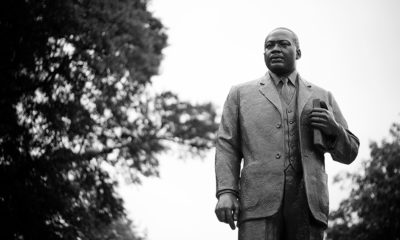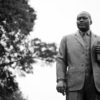Current Events
Racism Returns In Trayvon Martin Case
Attorney in Zimmerman trial attempts to argue pot drove Trayvon Martin to violence
On the night of February 26, 2012 George Zimmerman of Sanford, Florida, who had been patrolling his neighborhood in the wake of a rash of break-ins, told police that the hoodie-clad teenager had looked suspicious. His lawyers later argued that the teen had attacked Zimmerman, necessitating self-defense.
The teen, 17-year-old Trayvon Martin, cannot tell his story; he had been shot dead by Zimmerman that same evening.
In such tragic situations surrounded by incomplete and obscure information, criminal trials often obsess over which alleged facts may be presented and which must remain beyond the ken of the jury. Such was the drama on display Monday in a trial which has captivated a nation with its themes of racial injustice and neighborhood security, when Judge Debra Nelson ruled that the defense may present evidence that Martin had THC in his system when he died. But Nelson’s ruling is deeply troubling, because its implications land squarely in the middle of a long, broad legacy of racism.
The Shadow of the Past…
The notion that cannabis intoxication leads to violent aggression came to the United States by way of Mexico, where popular folklore held that soldiers, criminals, and other members of the lower classes would smoke mariguana prior to nefarious deeds and sometimes even ran amok, destroying everything in sight. But the first American to adapt such folklore for a domestic audience was New Orleans District Attorney Eugene Stanley. As the city’s top prosecutor in the late 1920s, Stanley certainly had his hands full; the city had been suffering through one of the worst crime waves of its history.
Stanley seized on cannabis, which had recently poured into the city from its wharves, as a scapegoat. His widely circulated pamphlet, “Marihuana as a Developer of Criminals,” draws the connection:
At the present time the underworld has been quick to realize the value of this drug in subjugating the will of human derelicts to that of a master mind. Its use sweeps away all restraint, and to its influence may be attributed many of our present-day crimes… immediately before the commission of many crimes the use of marihuana cigarettes has been indulged in by criminals so as to relieve themselves from the natural restraint which might deter them from the commission of criminal acts, and to give them the false courage necessary to commit the contemplated crime.
Harry Anslinger, the first Commissioner of the Federal Bureau of Narcotics and the nation’s first architect of anti-cannabis policy, adopted Stanley’s message and added a decidedly racist flair. His reliable “gore file,” sought to document every lurid incident, whether real or imagined, tying cannabis use to racial divides and violence of the worst possible character:
West Va. – Negro raped a girl eight years of age.
Two Negros [sic] took a girl fourteen years old and kept her for two days in a hut under the influence of marihuana. Upon recovery she was found to be suffering from syphilis.
Over time, the bogeyman of the American public began to resemble a young black man. Once white college students began to seek out the liberating jazz clubs of Harlem, Anslinger accused the (mostly black) musicians of using “reefers” to assure the sexual compliance of young white women. Thirty years later, the specter of the drug-addled black youth would surface again, during the crack scare of the “Just Say No” ’80s.
…Resurfaces in the Present
In the wake of Monday’s evidentiary ruling, CNN host Piers Morgan had Mark O’Mara, the attorney for George Zimmerman, appear as a guest on his show. Morgan asked about the ruling right out of the gate. It had been a dramatic reversal in the trial; the medical examiner who performed Martin’s initial autopsy had detected the marijuana but had decided that cannabinoid levels were too low to have any real effect; Judge Nelson herself had previously ruled the toxicology report inadmissible. But then the medical examiner changed his mind, and soon Nelson had done the same.
Morgan scoffed. Given the low dose detected, and given what is known about the drug’s effects, he questioned whether any real expert could conclude that the drug could have made Martin aggressive.
O’Mara responded: “Well, actually, there are some studies out there – particularly with young males – that suggest that even low levels of cannabis use can lead to aggression.” O’Mara cited no sources, and it’s unclear which studies he referred to.
Nelson’s ruling does not necessarily mean that she agrees with O’Mara’s statement; the toxicology report could also be relevant under the theory that it supports Zimmerman’s contention that he believed that Martin was under the influence of drugs which could have made him dangerous. Zimmerman is on trial for murder, and one required element of a murder charge is that the defendant had willful, malicious intent at the time of the act. If Zimmerman can prove that he honestly believed at the time of the shooting that he had to open fire in order to protect his own life, the charge could be reduced to manslaughter or even acquitted entirely, because he lacked the mental state necessary for murder. And if that is what Zimmerman truly believed, then the prejudice of the past can still provoke a grave miscarriage of justice today.
Meanwhile, Judge Nelson has not yet ruled on the admissibility of an EMS report, showing that Zimmerman had been under the influence of two separate benzodiazepines, known to provoke confusion, agitation, and aggression.


























